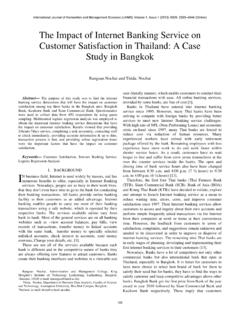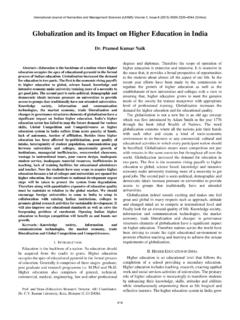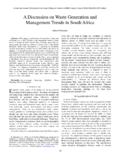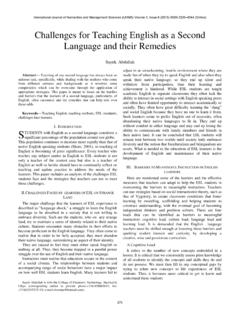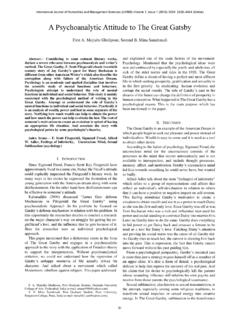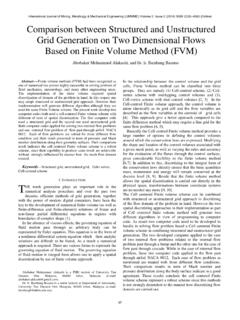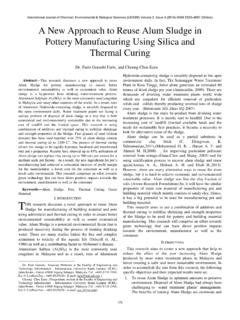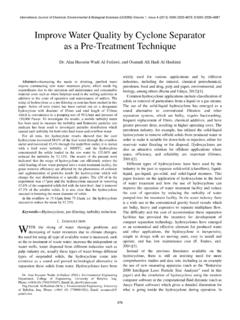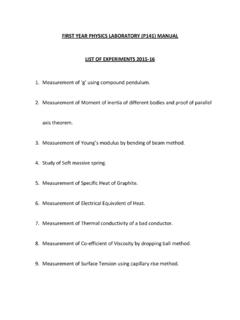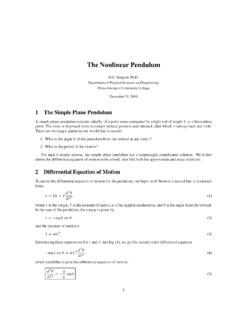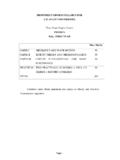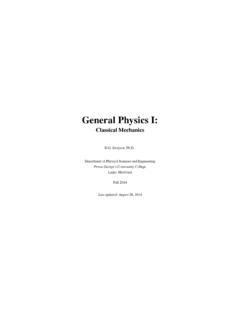Transcription of Mechanical Properties and Loss on Ignition of …
1 Abstract Resin bonded sand casting offers advantage than green sand casting in terms of strengthening of the mould by means of adding resin binders and hardeners. In this work, two sets of binders and catalyst were used to understand the effect of different ratio of these binders and hardeners to the Mechanical Properties and loss of Ignition (LOI) of the mould. Phenolic and ester in the first set and furan and sulfonic acid in the second set were used as binders and hardeners, respectively. The moulds were then studied for their tensile, transverse and compressive Properties as well as LOI. The results also suggest the best set of ratios that could comply with the nominal Properties required by manufacturers. This study is a preliminary work for the development of biodegradable resin bonded sand casting. Index Terms Resin bonded sand casting, Phenolic Resin, Furan, Mechanical Properties , loss on Ignition . I. INTRODUCTION Sand casting developed more than 6,000 years back due to the needs of shaping copper that was only can be shaped for relatively simple forms using forging process.
2 Nowadays, sand casting is commonly used to form wide variety of metal components with intricate shape and geometries. Automotive components such as engine blocks, manifolds, cylinder heads and transmission cases are among typical components made of sand casting process besides other vast applications. Sand casting process can be divided into three operations fabrication of pattern, making of the mould and pouring of the raw materials. This study focuses on the process of mould making and therefore only this operation will be reviewed in this section. In making of the mould, the sand particles are held together by a typical mixture of 90% silica sand, 3% water and 7% clay. Other bonding agents can be used in place of clay, including organic and inorganic binders. Additives (catalysts or hardeners) are sometimes combined with the mixture of sand and binder to enhance Properties such as strength of the mould [1]. Sand casting with these mixtures is called resin bonded sand casting.
3 It is claimed can give better dimensional accuracy on cast product than the green sand process [2]. Resin bonded sand consists of 93-99% silica and 1-3% binders [3]. Binders give bond, cohesion and strength to the mixed sand during mould ramming to ease the shaping process and retain it shape under pressure, temperature and erosion of liquid metal during pouring process. Among most This work was supported by the Universiti Teknikal Malaysia Melaka under the short term grant of PJP/2011/FKP(30A)/S00996. N. I. S. Hussein, the corresponding author, is a senior lecturer of the Faculty of Manufacturing Engineering, Universiti Teknikal Malaysia Melaka (e-mail: izan@ ). common resins used in the foundry in Malaysia are phenolic and furan. A highly alkaline phenolic resin generally containing up to 25% potassium hydroxide is used as binder in ester no bake process [4]. No bake process is another name for resin bonded sand casting in which resin is self-setting at room temperature.
4 In phenolic-ester no bake mould, 2% of the phenolic resin (based on the weight of sand) is first blended into the sand, followed by about 20% of an ester (based on weight of resin) [4]. The reaction between the ester and phenolic resin leads to curing and solidification. Since the binders are free of nitrogen and sulfur, it affords foundry engineering advantages for steel, nodular iron and aluminum casting. Furan resin is made of from fufuryl alcohol and its most important application is in foundry industry. It is somewhat more expensive than other binders but the possibility of sand reclamation is advantages. One of the advantages of furan binders over phenolic resin are in fact it has free phenol level, low formaldehyde, and produce less odor and smoke during casting process [5]. No bake furan mould is used in casting all kinds of cast steel, cast iron, non-ferrous metal castings. 100 parts by weight of sand are mixed with 20 30 parts of by weight of an aqueous acid catalyst and to this mixture is then added a quantity of of 1 to 2 parts by weight of suitably compounded furan resin to give a mould material solidifying to the desired strength and in the desired period of time [5].
5 Materials known to be suitable for curing furan resin include hydrochloric acid, sulfuric acid, nitric acid, phosphoric acid, tartaric acid, maleic acid and sulfonic acid [6]. Brown [2] suggested that hardener ratio for furan system to be between 40 60%. Sand testing is essential to understand the Properties of the resin bonded sand mould. Some of the most important sand testing are moisture, permeability, strength, compactability and loss of Ignition (LOI) test [2]. In this study, tensile, transverse and compression testing and LOI were employed. This study is a preliminary work for the development of biodegradable resin bonded sand casting. High cost of silica sand, the growing cost of disposing the used foundry sand and hazard due to the disposal on non-biodegradable binders and hardeners to the environment have become motivation to the development of the biodegradable sand mould. II. OBJECTIVES OF THE STUDY The main objectives of this work were, firstly, to study the effect of different ratio of binders and hardeners to the tensile, transverse and compression test Properties and LOI of the resin bonded sand casting moulds, secondly, to compare between the phenolic-ester and furan-sulfonic acid bonded sand casting in terms of the Mechanical Properties and LOI Mechanical Properties and loss on Ignition of Phenolic and Furan Resin Bonded Sand Casting N.
6 I. S. Hussein, M. N. Ayof, and N. I. Mohamed Sokri, Faculty of Manufacturing Engineering, Universiti Teknikal Malaysia Melaka International Journal of Mining, Metallurgy & Mechanical Engineering (IJMMME) Volume 1, Issue 3 (2013) ISSN 2320-4052; EISSN 2320-4060223 and, finally, to suggest set of resin-binder ratio that could give Properties to those outlined by the manufacturers. III. EXPERIMENTAL METHODS A. Design of Experiment Based on values suggested from the review and manufacturer specification a set of variables were determined. Table 1 shows the total weight of phenolic resin and ester hardener based on the percentage ratio. Table 2 shows the total weight of furan resin and sulfonic acid hardener. The weight calculations were based on the weight of sand used to produce each sample 3kg. TABLE I. TOTAL WEIGHT OF PHENOLIC RESIN AND ESTER BASED ON PERCENTAGE RATIO Sample No. Sand (kg) Phenolic resin (%) by weight of sand Resin Weight (g) Ester (%) by weight of resin Hardener Weight (g) 1 3 60 25 15 2 3 75 25 3 3 90 25 4 3 90 30 27 5 3 75 30 6 3 75 20 15 7 3 90 20 18 8 3 60 30 18 9 3 60 20 12 TABLE II.
7 TOTAL WEIGHT OF FURAN RESIN AND SULFONIC ACID BASED ON PERCENTAGE RATIO Sample No. Sand (kg) Furan resin (%) by weight of sand Resin Weight (g) Sulfonic acid (%) by weight of resin Hardener Weight (g) 1 3 66 55 2 3 66 60 3 3 72 55 4 3 72 60 5 3 60 50 30 6 3 66 50 33 7 3 60 55 33 8 3 72 50 36 9 3 60 60 36 B. Sample Preparation The sand, resin and hardener were weighted by using a digital scale and poured into a sand mixer. They were mixed for 10 seconds. The sand mixture was taken out from the mixture through a gate and put into moulds for tensile, transverse and compression testing. The samples were cure for 20 minutes before they were taken out of the moulds. Figure 1 shows the tensile, transverse and compression test moulds filled up with the sand mixture. The same procedures were repeated for all set of sample number. Total of 5 samples were prepared for each sample number. Fig. 1 Moulds and samples for tensile, transverse and compression testing and LOI.
8 C. Samples Testing Tensile testing of the samples in a shape of dumbbell or dog bone was performed after 24 hours of the moulding and curing process. Motor driven universal sand strength machine model US-M was employed for the tensile test. The samples were clamped between attachments as shown in Figure 2. The load was set to 120 kgcm-2. The attachments were pendulum type. Tensile force was applied until the samples were broken into two parts. Reading was taken based on the distance where the magnet bar stopped. Tensile strength was determined by Equation 1. Tensile strength (kgcm-2) = *reading at magnet bar (1) Fig. 2 A sample was clammped between the attachments of the universal sand strength machine Using the same machine, the attachments for tensile testing were disassembled and attachments for transverse test were mounted. It consists of specimen holder and knife-edge. Transverse test was performed to measure the bending strength.
9 The sample was placed in vertical position and the knife-edge pressed at the center until it was broken into two parts. Reading at the position of the magnet bar stopped was recorded. Transverse strength was read based on Equation 2. Figure 3 (a) shows the sample for transverse strength test. Transverse strength(kgcm-2)= *reading at magnet bar (2) Compressive strength test was performed using a universal testing machine (UTM). Samples for the test were cylindrical shape with 50 mm diameter and 50 mm height (Figure 3(b)). The sample was placed in between a compression holder. The sample was pressed at load of 1200 N until the sample was broken. Result was displayed from the aided software. International Journal of Mining, Metallurgy & Mechanical Engineering (IJMMME) Volume 1, Issue 3 (2013) ISSN 2320-4052; EISSN 2320-4060224 (a) (b) Fig. 3 Samples for (a) tranverse strength and (b) compressive strength testing D.
10 loss on Ignition (LOI) loss on Ignition was performed to test to measure amount of moisture or impurities loss when the sample was ignited. It also determines the presence of organic or other gas forming materials in the sand mixture. Sand mixture according to ratio set in Table I and II was weighted for 10 g and put into a crucible. The samples were then heated at 1000 C for 30 minutes in a port clay kiln. After the samples were taken out of the kiln or oven, they were immediately placed in desiccators. The samples were again weighted and LOI was measured according to initial weight minus final weight and divided by the initial weight in unit gram. IV. RESULTS AND DISCUSSION A. Tensile, Transverse and Compressive Strength 1) Phenolic Ester Sand Mould Table III shows results for tensile, transverse and compressive strength for phenolic ester bonded sand moulds. The values were averaged from 5 samples for each set of percentage ratio.

